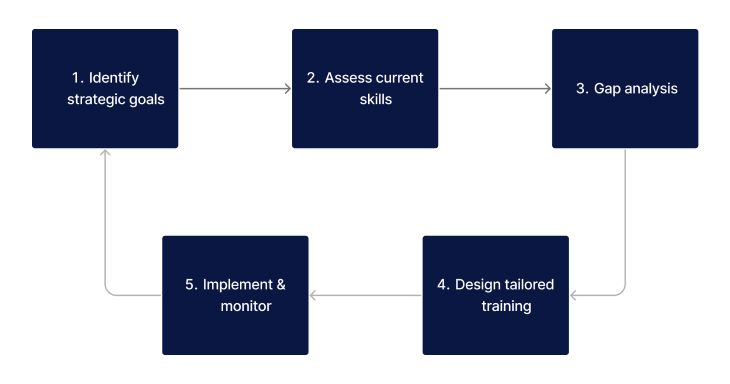In the fast-evolving landscape of the Australian healthcare system, aligning employee training programs with organisational goals has become crucial. This article explores the significance, methodology, and implications of this alignment in healthcare training (Becker, 2013).
Why is Aligning Training Programs with Organisational Goals Important?
Alignment between training programs and organisational goals ensures that employee skill development directly contributes to the strategic objectives of the health system. This synergy leads to increased productivity, improved employee performance, and enhanced healthcare delivery (Goldstein & Ford, 2002).
Steps to Align Training Programs with Organisational Goals

1. Identify Strategic Goals
Begin by defining the long-term and short-term goals of your organisation. This involves understanding the overarching objectives and how these goals reflect the mission and vision of the health system. Clarity in strategic goals ensures that subsequent training is relevant and focused (Bates, 2014).
2. Assess Current Skills
Conduct a thorough assessment of the existing skills and knowledge within your workforce. This step involves evaluating the competencies of your staff and identifying areas where improvements are needed. It's crucial to understand the current skillset to tailor the training effectively (Noe, 2017).
3. Gap Analysis
After assessing current skills, perform a gap analysis. This involves identifying the discrepancies between the skills your employees currently possess and the skills needed to achieve the set organisational goals. This step is vital in pinpointing the specific areas where training is required (Lawson, 2002).
4. Design Tailored Training
Based on the gap analysis, design training courses that specifically address the identified skill gaps. This could include a mix of on-the-job training, workshops, seminars, and e-learning modules. The training should be customised to meet the unique needs of your organisation and its employees (Becker, 2013).
5. Implement and Monitor
Execute the training sessions with a clear plan and monitor the progress regularly. This involves not only the delivery of training but also tracking the effectiveness of these programs in terms of improving skills and contributing to the organisational goals. Continuous monitoring allows for adjustments and improvements in the training process (Kirkpatrick & Kirkpatrick, 2006).
Want a healthcare LMS that can support your healthcare organisational goals?
Contact Ausmed today and see how we can support your organisation!
Why You Shouldn’t Create a Learning Program After Your Business Strategy
Developing a learning program post-strategy formulation can lead to misalignment. It's essential that employee training programs are considered during strategy development to ensure they are tailored to support the desired outcome and operative goals (Lawson, 2002).
Considerations for Aligning Training Programs with Organisational Goals

When aligning training programs with organisational goals, there are several critical considerations to keep in mind. These factors ensure that the training is not only effective in meeting strategic objectives but also responsive to the needs of the employees and the evolving trends in the healthcare sector.
| Consideration | Description |
|---|---|
| Employee Needs | Consider the individual learning needs and mental health of employees. |
| Healthcare Trends | Stay updated with current trends in the healthcare system. |
| Technology Integration | Incorporate modern technology in training for enhanced learning (Noe, 2017). |
Pros and Cons of Aligning Training Programs with Organisational Goals
Aligning training programs with organisational goals has its advantages and challenges. Understanding these pros and cons is essential for developing an effective training strategy that maximises benefits while addressing potential drawbacks (Goldstein & Ford, 2002).
| Pros | Cons |
|---|---|
| Enhanced Employee Performance: Improved skills and competencies leading to better job performance. | Potential Initial Cost: High initial expenses for developing and implementing aligned training programs. |
| Increased Organisational Productivity: Effective training leading to higher overall performance and productivity. | Time-Intensive Development: Significant time investment required for creating relevant training programs. |
| Targeted Skill Development: Focus on specific skills needed to achieve organisational goals. | Continuous Update Required: Need for ongoing updates to keep the training relevant and effective. |
| Improved Employee Engagement: Training aligned with organisational goals can increase employee motivation and job satisfaction. | Risk of Misalignment: If not carefully designed, training programs might misalign with actual organisational goals. |
| Better Resource Utilisation: Efficient use of resources by focusing training on key organisational objectives. | Employee Resistance: Potential resistance from employees to new training methods or content. |
| Supports Strategic Changes: Facilitates smoother transitions when organisational strategies change. | Overdependence on Training: Overemphasis on formal training at the expense of on-the-job learning and innovation. |
Related Resources
- Guide to Mandatory Training
- LMS in Healthcare: The Roles, Benefits and Pros and Cons
- What Are Learning Analytics?
- What Are the Key Learning Analytics Metrics?
- How to Create a Culture of Continuous Learning
- How to Manage an Effective Staff Training Program
- Identifying Skills Gaps with Learning Analytics
- A Guide to Personalised Learning in Healthcare
Conclusion
Aligning training programs with organisational goals in the healthcare sector is a strategic approach that fosters an effective workforce capable of meeting the dynamic demands of the health system. While it requires careful planning and resources, the long-term benefits for both employees' skill enhancement and organisational growth are significant (Bates, 2014).
References
- Bates, R. (2014). ‘Aligning Organizational Culture with Training and Development Strategies’, Advances in Developing Human Resources, 16(4), pp. 454-467.
- Becker, K. (2013). ‘Developing Healthcare Training Programs: A Strategic Approach’, Journal of Healthcare Leadership, 5, pp. 29-38.
- Goldstein, I.L. & Ford, J.K. (2002). Training in Organizations: Needs Assessment, Development, and Evaluation, 4th ed. Wadsworth Publishing.
- Kirkpatrick, D.L. & Kirkpatrick, J.D. (2006). Evaluating Training Programs: The Four Levels, 3rd ed. Berrett-Koehler Publishers.
- Lawson, K. (2002). The Trainer's Handbook, 2nd ed. Pfeiffer.
- Noe, R.A. (2017). Employee Training and Development, 7th ed. McGraw-Hill Education.



